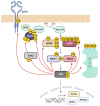Navigating the ERK1/2 MAPK Cascade
- PMID: 37892237
- PMCID: PMC10605237
- DOI: 10.3390/biom13101555
Navigating the ERK1/2 MAPK Cascade
Abstract
The RAS-ERK pathway is a fundamental signaling cascade crucial for many biological processes including proliferation, cell cycle control, growth, and survival; common across all cell types. Notably, ERK1/2 are implicated in specific processes in a context-dependent manner as in stem cells and pancreatic β-cells. Alterations in the different components of this cascade result in dysregulation of the effector kinases ERK1/2 which communicate with hundreds of substrates. Aberrant activation of the pathway contributes to a range of disorders, including cancer. This review provides an overview of the structure, activation, regulation, and mutational frequency of the different tiers of the cascade; with a particular focus on ERK1/2. We highlight the importance of scaffold proteins that contribute to kinase localization and coordinate interaction dynamics of the kinases with substrates, activators, and inhibitors. Additionally, we explore innovative therapeutic approaches emphasizing promising avenues in this field.
Keywords: ERK1/2; MAPKs; cancer; inhibitors; scaffold; therapies.
Conflict of interest statement
The authors declare no conflict of interest.
Figures





Similar articles
-
Targeting ERK1/2 protein-serine/threonine kinases in human cancers.Pharmacol Res. 2019 Apr;142:151-168. doi: 10.1016/j.phrs.2019.01.039. Epub 2019 Feb 20. Pharmacol Res. 2019. PMID: 30794926 Review.
-
IQGAP1 scaffold-kinase interaction blockade selectively targets RAS-MAP kinase-driven tumors.Nat Med. 2013 May;19(5):626-630. doi: 10.1038/nm.3165. Epub 2013 Apr 21. Nat Med. 2013. PMID: 23603816 Free PMC article.
-
Targeting the Raf-MEK-ERK mitogen-activated protein kinase cascade for the treatment of cancer.Oncogene. 2007 May 14;26(22):3291-310. doi: 10.1038/sj.onc.1210422. Oncogene. 2007. PMID: 17496923 Review.
-
Mitogen-activated protein kinases and Hedgehog-GLI signaling in cancer: A crosstalk providing therapeutic opportunities?Semin Cancer Biol. 2015 Dec;35:154-67. doi: 10.1016/j.semcancer.2015.08.003. Epub 2015 Aug 17. Semin Cancer Biol. 2015. PMID: 26292171 Review.
-
The MAP kinase signaling cascades: a system of hundreds of components regulates a diverse array of physiological functions.Methods Mol Biol. 2010;661:3-38. doi: 10.1007/978-1-60761-795-2_1. Methods Mol Biol. 2010. PMID: 20811974 Review.
Cited by
-
Huanglian Jiedu decoction alleviates neurobehavioral damage in mice with chronic alcohol exposure through the RAS-RAF-MEK-ERK pathway.Heliyon. 2024 Apr 12;10(8):e29556. doi: 10.1016/j.heliyon.2024.e29556. eCollection 2024 Apr 30. Heliyon. 2024. PMID: 38644875 Free PMC article.
-
Natural products modulating MAPK for CRC treatment: a promising strategy.Front Pharmacol. 2025 Mar 5;16:1514486. doi: 10.3389/fphar.2025.1514486. eCollection 2025. Front Pharmacol. 2025. PMID: 40110122 Free PMC article. Review.
-
Nuclear Focal Adhesion Kinase Protects against Cisplatin Stress in Ovarian Carcinoma.Cancer Res Commun. 2024 Dec 1;4(12):3165-3179. doi: 10.1158/2767-9764.CRC-24-0382. Cancer Res Commun. 2024. PMID: 39585085 Free PMC article.
-
Advances in ERK Signaling Pathway in Traumatic Brain Injury: Mechanisms and Therapeutic Potential.Neurochem Res. 2025 Jun 9;50(3):191. doi: 10.1007/s11064-025-04449-0. Neurochem Res. 2025. PMID: 40489029 Review.
-
Evaluation of Gene Expression and the Regulatory Role of microRNAs Related to the Mitogen-Activated Protein Kinase Signaling Pathway in Human Retinal Pigment Epithelial Cells Treated With Lipopolysaccharide A and Tacrolimus.Mediators Inflamm. 2025 Jul 1;2025:8586711. doi: 10.1155/mi/8586711. eCollection 2025. Mediators Inflamm. 2025. PMID: 40630080 Free PMC article.
References
Publication types
MeSH terms
Grants and funding
LinkOut - more resources
Full Text Sources
Medical
Miscellaneous

